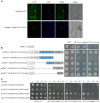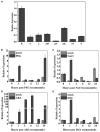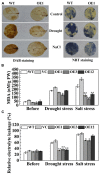A Wheat R2R3-type MYB Transcription Factor TaODORANT1 Positively Regulates Drought and Salt Stress Responses in Transgenic Tobacco Plants
- PMID: 28848578
- PMCID: PMC5550715
- DOI: 10.3389/fpls.2017.01374
A Wheat R2R3-type MYB Transcription Factor TaODORANT1 Positively Regulates Drought and Salt Stress Responses in Transgenic Tobacco Plants
Abstract
MYB transcription factors play important roles in plant responses to biotic and abiotic stress. In this study, TaODORANT1, a R2R3-MYB gene, was cloned from wheat (Triticum aestivum L.). TaODORANT1 was localized in the nucleus and functioned as a transcriptional activator. TaODORANT1 was up-regulated in wheat under PEG6000, NaCl, ABA, and H2O2 treatments. TaODORANT1-overexpressing transgenic tobacco plants exhibited higher relative water content and lower water loss rate under drought stress, as well as lower Na+ accumulation in leaves under salt stress. The transgenic plants showed higher CAT activity but lower ion leakage, H2O2 and malondialdehyde contents under drought and salt stresses. Besides, the transgenic plants also exhibited higher SOD activity under drought stress. Our results also revealed that TaODORANT1 overexpression up-regulated the expression of several ROS- and stress-related genes in response to both drought and salt stresses, thus enhancing transgenic tobacco plants tolerance. Our studies demonstrate that TaODORANT1 positively regulates plant tolerance to drought and salt stresses.
Keywords: MYB; abiotic stress; antioxidation system; stress related genes; wheat.
Figures









References
-
- Bartels D., Sunkar R. (2005). Drought and salt tolerance in plants. Crit. Rev. Plant. Sci. 24 23–58. 10.1080/07352680590910410 - DOI
LinkOut - more resources
Full Text Sources
Other Literature Sources
Miscellaneous

